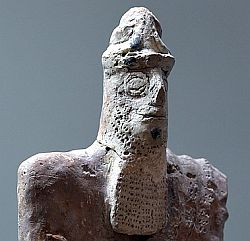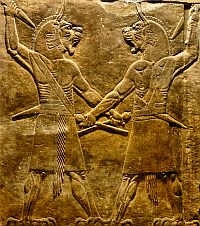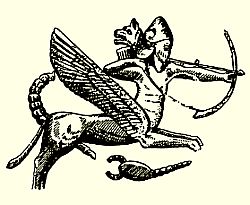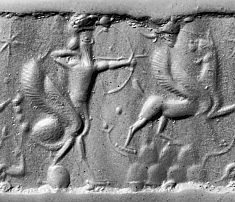
|
|
MesopotamiaStar Lore
|
|



|
|
Andromeda
In ancient Mesopotamia the stars of the constellation
later known as Andromeda belonged to three different asterisms.
|
 Apin, Anunitun and 1-Iku; stars of Andromeda highlighted by the author
Apin, Anunitun and 1-Iku; stars of Andromeda highlighted by the authorSource: Dream Voyager |

Anunitum consisted of the stars of the northern fish of Pisces, together with
β and δ Andromedae and some of the
neighboring stars.
 Danielle Adams traces the origin of the Great Fish of the Arabian Desert (see below) back to ancient Babylon but points out that it is unknown when this constellation was first recognized.  Sources: Gavin White, J.H. Rogers, Danielle Adams |
 Anunitum, the Great Babylonian Fish
Anunitum, the Great Babylonian FishSource: Danielle Adams
|
 Anunitum, the patron goddess of the Sumerian city of Akkad was closely affiliated to Inanna-Ishtar, the Mesopotamian goddess of love, beauty, sex, war, justice and political power.  Inanna-Ishtar was sometimes envisioned holding a sacred fish and a dove. As a seasonal symbol, the fish of Anunitum represented river carps swiming upstream during the spring floods of the Tigris river.  Also called "Lady of the Heavens", Anunitum was a spiritual guide. Like the carps on the way to their spawning grounds, she guided the sun on its ascending path from the darkness of winter towards spring.  The name KA.MUSH.I.KU.E (The Deleter) in the  |

A number of stars of Andromeda, together with Cassiopeia were also part of the
Babylonian constellation called LU-LIM, the Stag or the Messenger of the Stars.
 According to Gavin White, the stag "... is frequently associated with the sun and the rekindling of fire – sometimes it is even portrayed pulling the chariot of the sun instead of the more familiar horse. The constellation of the Stag rises just after mid-winter and is no doubt stationed in this region of the heavens to symbolize the rebirth of the sun after its winter-time death."  Click here, to see a map ob Babylonian constellations, compiled by J.H. Rogers.  Sources: Gavin White, J.H. Rogers. |
 Stag constellation drawn by the author with Andromeda part in red.
Stag constellation drawn by the author with Andromeda part in red.
|

|
An unidentified object in the MUL.APIN Tables is called dHARRIRU, the Rainbow.
J.H. Rogers sees a possibility that this might be the Andromeda Galaxy.  Source: J.H. Rogers |



|
|
Aquarius
In Babylonian star catalogues, the constellation later known as Aquarius
was listed as GU.LA, meaning "The Great One."
|

|
Aquarius was also associated with the destructive floods that the Babylonians regularly experienced; a concept that was adopted in ancient Egypt as well.
 Sources: Wikipedia and J.H. Rogers: Origins of the ancient constellations |



|
|
Aquila
In the Three Stars Each tables, the constellation was listed as
A-mushen, the Eagle.
|

|



|
|
Ara
Seen from Mesopotamia, the stars of Apus are just above the horizon. The constellation was
part of an early Accadian Zodiac and was named Tul-Ku, the Holy Mound.
|

|



|
|
Argo Navis
According to J.H. Rogers, in the
Babylonian Three Stars Each Table, the stars that later became the
constellation Carina, including the bright
Canopus (α Car) were called BIR, which translates to Kidney.
|
 Ninhursag
NinhursagSource: historyten.com/mesopotamia |

Special attention was given to the star η Carinae. In the
MUL.APIN tables, it was listed as gishGAN.UR,
which J.H. Rogers translates as
"the star which stands at its side: the Harrow, the weapon of Mar-biti, inside of which one sees the subterranean waters."
 This may have included the Carina Nebula, a large, complex area of bright and dark nebulosity. This nebula was not visible in Europe, it was re-discovered by Nicolas-Louis de Lacaille in 1752.  According to R.H. Allen, "This is one of the most noted objects in the heavens, perhaps even so in almost prehistoric times, for Babylonian inscriptions seem to refer to a star, noticeable from occasional faintness in its light, that Jensen thinks was η. And he claims it as one of the temple stars associated with Ea, or Ia, of Eridhu, the Lord of the waves, otherwise known as Oannes, the mysterious human fish and greatest god of the kingdom."  Sources: Wikipedia and J.H. Rogers, R.H. Allen |
 Oannes
Oannes© Granger Historical Picture Archive |



|
|
Aries
In Babylonian star catalogues, the constellation later known as Aries
was listed as MUL.LÚ.ḪUN.GÁ, meaning "The Agrarian Worker" or "The Hired Man."
Wikipedia tells us, that "...the earliest identifiable reference to Aries as a
distinct constellation comes from boundary stones that date from 1350 to 1000 BC. On several
boundary stones, a zodiacal ram figure is distinct from the other characters present. The shift in identification from the constellation as the
Agrarian Worker to the Ram likely occurred in later Babylonian tradition because of its growing association with
Dumuzid the Shepherd.
|
 Ancient Sumerian depiction of the marriage of Inanna and Dumuzid
Ancient Sumerian depiction of the marriage of Inanna and DumuzidSource: Wikipedia
|


|
|
In Zoroastrianism, the star 41 Arietis was
associated with the Yazad (angel) Upa-paoiri.
 Source: Wikipedia |



|
|
Boötes
In Babylonian star catalogues, the constellation later known as Boötes
was listed as MUL.SHU.PA.
|
 Statuette of Enlil, 1800 – 1600 BC
Statuette of Enlil, 1800 – 1600 BCSource: Wikipedia
|



|
|
Cancer
The MUL.APIN tables list an asterism called AL.LUL, which
translates to "deceptive digger." J.H. Rogers refers to this entry as "the crab" and "the seat of Anu."
|
 Babylonean turtle amulet
Babylonean turtle amuletSource: British Museum |



|
|
Canis Major
In the Mesopotamian Three Stars Each table, dating to around 1200 BC,
Sirius, was named named KAK.SI.DI. It was was seen as an arrow aiming towards
Orion, while the southern stars of Canis Major and a part of
Puppis were viewed as a bow, named BAN.
|

|



|
|
Canis Minor
In the Mesopotamian Three Stars Each table, dating to around 1200 BC,
Procyon and Gomeisa were named
MASH.TAB.BA., meaning "twins."
|
 Ugallu and Lulal, Nineveh, 645 BC
Ugallu and Lulal, Nineveh, 645 BCSource: Jonathan Cohen |



|
|
Capricornus
In the MUL.APIN star catalog, Capricornus was called
MULSUḪUR.MAŠ, which means "Goat Fish." It was associated with Enki, the
Sumerian god of of water, knowledge, mischief, crafts, and creation. Eki's characteristic symbols were a bird, a goat and flowing water.
 |

|
One simple reason for the naming of the constellation may have been the fishing season for
goat fishes (Parupeneus forsskali), which coincided with the
Heliacal rising of MULSUḪUR.MAŠ.
 Source: German Wikipedia
|
 Goatfish; Wikipedia
Goatfish; Wikipedia
|



|
Centaurus
The constellation can be traced back to Mesopotamian roots, but details are sketchy.
J.H. Rogers makes no mention of MUL.GUD.ALI. He defines Centaurus as EN.TE.NA.MASH.LUM in the
Three Stars Each and as EN.TE.NA.BAR.HUM in the
MUL.APIN tables and relates the constellation to
Ningursu, the Sumerian god of agriculture and healing.
Gary D. Thompson also refers to EN.TE.NA.BAR.HUM, adding that the term has not yet been translated but may refer to a mouse or a rodent.
|



|
|
Gemini
In the MUL.APIN Tables, the stars later known as Castor and Pollux
were known as the Great Twins. The Twins were regarded as minor gods and were called
Lugal-irra and Meslamta-ea, meaning respectively "The Mighty King" and "The One who has arisen from the Underworld."
|
 Reconstruction of the Great Twins
Reconstruction of the Great TwinsGavin White: Babylonian Star-lore |



|
|
Hydra
In the Babylonian star catalogues, the constellation later known as Hydra (including
β Cancri, the bottom star of the constellation Cancer)
was listed as MUL.DINGIR.MUŠ.
In Sumerian and
Babylonian Mythology, the constellation was related to
Nirah, a snake god.
On boundary stones (right), Nirah often appeared on the upper edge, "enclosing" the stone
document (which usually was a real estate deed).
|
 Nirah on a Babylonian boundary stone
Nirah on a Babylonian boundary stoneSource: Wikipedia
|



|
|
Leo
Archaeological evidence suggests that the Mesopotamians had a Lion constellation as early as 4000 BC.
J.H. Rogers points out that
early Mesopotamian artwork depicted large numbers of lions, bulls and (to a lesser amount) scorpions as symbols of power.
 Some mythologists believe that in Sumeria, Leo represented the monster Humbaba, a monstrous giant with a lion's face.  Sources:Wikipedia, J.H. Rogers: Origins of the ancient constellations., Gavin White: Babylonian Star-Lore |
 Lion at Babylon's Ishtar Gate
Lion at Babylon's Ishtar GatePicture taken by the author
|



|
|
Libra
In Babylonian star catalogues, the constellation later known as Libra
was listed as MUL.ZIB.BA.AN.NA, meaning "The Balance of Heaven." The scales were held sacred to the sun god
Šamaš, who was also the patron of truth and justice.
Gavin White explains: "The constellation of the Scales, which was formed from
the Scorpion’s Claws long ago, is held to be particularly sacred to the sun god Šamaš. In the first place, the Scales symbolize the autumn
equinox, when the watches of day and night are held to be of equal duration and the sun rises due east and sets due west. And secondly, the Scales
symbolize the idea of judicial prudence, as in the phrase "weighing up the evidence", which is particularly appropriate to the sun god as his
principle role within the Babylonian pantheon was to act as the arbitrator of truth and justice. For these reasons the Scales are thought to be the
special station of the sun in Babylonian astrology, where they are purposefully set opposite to the moon’s station in the Star Cluster (the Pleiades)."
|

|



|
|
Lyra
In Babylonian Star Catalogues, Lyra is listed as a goat, called
UZA.
Around 12,000 BC, Vega, the brightest star in the constellation and the
fifth-brightest star in the night sky, was the northern pole star. As such, it received
special attention in Mesopotamia.
In Babylonian astronomy, Vega may have been one of the stars named Dilgan, "the Messenger of Light".
|



|
|
Milky Way
 In the Babylonian creation myth Enűma Eliš, the Milky Way is created when Marduk slayed the primeval salt water dragoness Tiamat, severed her tail and placed it in the sky.  In ancient Babylonian religion, Tiamat is the primordial goddess of the salt sea. She mated with Abzű, the god of fresh water, to produce younger gods. Tiamat is the symbol of the chaos of primordial creation.  Source:Wikipedia |
 Cylinder seal, 8th century BC, believed to
Cylinder seal, 8th century BC, believed todepict the slaying of Tiamat. Source:Wikipedia |



|
| Orion |

|
The constellation Orion originated with the Sumerians, who named it URU AN-NA, the "Light of Heaven." Next to it was the constallation
GUD AN-NA, the "Bull of Heaven", modern-day Taurus. The two constellations depicted Sumer's great hero Gilgamesh, fighting the Bull of Heaven. Sources: Ian Ridpath's Star Tales |
 Neo-Sumerian Terracotta Relief
Neo-Sumerian Terracotta Relief2250-1900 BC; Source: Wikipedia |


In Babylonian star catalogues, Orion is named "The Heavenly Shepherd" or
"True Shepherd of Anu" – (Anu was the chief god of the heavenly realms).
 Later Mesopotamian mythology would assimilate Ninshubur with the Akkadian messenger god Papshukal to become a herald to the general pantheon of gods.  On Babylonian border stones (carved stone used to mark a royal land grant), Papshukal is generally depicted as a walking bird. Sources: Wikipedia, Petros Koutoupis, J. H. Rogers, Astronomytrek |
 Babylonian Border Stone
Babylonian Border Stone1157-1025 BC Source: John Bedell |



|
|
Pisces Early Babylonian star tables (1200 BC) divided the constellation later known as Pisces into two asterisms. The northern fish was seen as Šinunutu4, "the Great Swallow," and the southwestern fish was called Anunitum, the "Lady of the Heaven." |
 Anunitum;
Source: G. White.
Anunitum;
Source: G. White.
|
| G. White connects Anunitum to the theme of solar rebirth after the winter solstice and writes: |

"The same theme of solar rebirth is expressed in a somewhat
different form in the adjacent constellations known as Anunitum, the Swallow and the Field. These star figures together constitute a vivid depiction
of the "myth of the Syrian goddess", which can be thought of as the master-myth of this season. The myth runs as follows – two fish found an enormous
egg floating in the depths of the river Euphrates, the fish guided the egg up from the watery depths of the river and rolled it onto dry land, where
a dove appeared and started to brood it. In due time, the Syrian goddess herself was born from the egg. On account of this myth, fish and birds were
held to be particularly sacred to the Syrian goddess."
 The "Syrian Godess" referred to in the myth is Atargatis, chief goddess of northern Syria in Classical antiquity. She was also known under the name Derketo, and was later in Greek Mythology fused with Aphrodite, closing the circle to the Greek Pisces legend involving Aphrodite and Eros. |

|

In some versions, the creatures guarding the egg were epic beings, half-fish, half-men named Aphros and Bythos.
 Later in the Babylonian Astronomical Diaries (600 BC), there was a notion of Rikis-nu.mi, "the fish cord or ribbon," which was the first fish-related reference to the later Zodiac constellation.  Sources: J.H. Rogers: Origins of the ancient constellations, R.H. Allen:Star Names, Their Lore and Meaning, brickthology.com, G. White: Babylonian Star Lore |



|
|
Pleiades
Both famous Babylonian star catalogues, the Three Stars Each
catalogue and the MUL.APIN tables, list the Pleiades as
MULMUL, literally meaning "Star Star," which can mean star cluster.
Jim A. Cornwell suggests that the
Seven Annunaki, could be related to the Pleiades (or to the Big Dipper). In the
Epic of Gilgamesh, the Annunaki
waited at the gates of hell to judge the newly-arrived souls.
The star cluster of the Pleiades is part of the constellation Taurus, but given the amount of Star Lore related to them, they deserve a separate entry. |

|



|
|
Sagittarius
Figures depicting a centaur armed with bow and arrow on Mesopotamian boundary stones date as far
back as the second millennium BC. In early legends, this figure may not yet have been tied to a constellation, but the depiction of an archer-centaur
overlapping a scorpion matches the position of Sagittarius and
Scorpius in the night sky.
 Pabilsaĝ was a tutelary God of the city of Isin.  Gavin White notes that "... The familiar image of the Greek constellation as a horse-centaur armed with a bow and arrow is, in fact, a simplified version of the Babylonian figure, which is a truly composite character with a number of features not seen in the Greek version, such as a set of wings, a scorpion’s tail and the head of a dog. The details of Pabilsaĝ's iconography show a considerable amount of variation."  Sources: J.H. Rogers: Origins of the ancient constellations, Ian Ridpath, G. White: Babylonian Star Lore |
 Centaur-Archer on Babylonian boundary stone
Source: J. H. Rogers
Centaur-Archer on Babylonian boundary stone
Source: J. H. Rogers
|



|
| Scorpius |

|
Ancient Mesopotamia
|
Around 3200 BC, three early zodiac constellations, lion, bull and scorpion had been defined. At that time, these constellations marked three
of the four cardinal points (both solstices and the spring equinox).
 Source: J. H. Rogers
In Babylonian star catalogues, Scorpius is called MUL.GIR.TAB,
meaning "The cutter" or "the (creature with) a burning sting".
In the same catalogue, Antares (α Scorpii) was called GABA GIR.TAB, meaning "the breast of the scorpion".
|
 Scorpion man on a cylindrical seal from
Scorpion man on a cylindrical seal fromthe Elamite capital Susa, ca. 2500 BC; Highlighted by the author Source: J. H. Rogers |

Antares may have also been known by the following names: Urbat, Bilu-sha-ziri ("the Lord of the Seed"), Kak-shisa ("the Creator of Prosperity"),
Dar Lugal ("The King"), Masu Sar ("the Hero and the King"), and Kakkab Bir ("the Vermilion Star").
 Source: Wikipedia
According to R.H. Allen, the
association of α Scorpii with Mars, which later resulted in the Greek name Antares, meaning "opponent to Ares (Mars)" had its origins in Mesopotamia.
|

In Mesopotamian cultures along the Euphrates, the asterism formed by
β, δ and
π Scorpii was called Gis-gan-gu‑sur, which
R.H. Allen translates as the
"Light of the Hero," or the "Tree of the Garden of Light."
 Allen continues writing that the tree was "... placed in the midst of the abyss and so reminding us of that other tree, the Tree of Life, in the midst of the Garden of Eden."  Source: R.H. Allen |
 Gis-gan-gu‑sur
Gis-gan-gu‑sur
|

In the MUL.APIN Tables,
λ and υ Scorpii were listed as
dSharur4 u dShargaz, meaning Sharur and Shargaz.
 In Mesopotamian Mythology, Sharur, meaning "Smasher of Thousands" and Shargaz, meaning "Protector" were the weapons of Ninurta, the Sumerian god of farming, healing, hunting, law, scribes and war. They were adorned with the heads of an eagle and of a panther. |
 Sharur
Sharur© CapitanCatalufo |
 Sharur and Shargaz
Sharur and Shargaz
|
| Sources: Wikipedia, J.H. Rogers, Mythology of all Races, Volume V |

The Epic of Gilgamesh, which was written circa 1600 BC tells us about the Scorpion's encounter
with Gilgamesh (Orion):
 On his journey to the homeland of Utnapishtim, Mesopotamian king Gilgamesh encounters initiated priests known as the scorpion-men.  Sources: Gnostic Warrior, Chandra Observatory, Project Gutenberg |
 Scorpion Man firing an arrow
Scorpion Man firing an arrowMiddle Assyrian cylinder seal Source: Wikiedia |
 Babylonian Border Stone
Babylonian Border Stone1157-1025 BC Source: John Bedell |

Later, scorpions also appeared on Babylonian border stones (carved stone used to mark a royal land grant).
 Sources: Wikipedia, Petros Koutoupis, J. H. Rogers, Astronomytrek |


Sumerian Star Names
 Starting about 4500 BC, Sumer was the earliest known civilization in southern Mesopotamia. Some of Scorpio's star names date back to the early days of the constellation and have remained unchanged for over 5,000 years.
Sargas (θ Sco) is Sumerian for "Stinger."
Girtab (κ Sco) was the Sumerian word for "Scorpion." It was originally applied to an
asterism consisting of κ, λ, υ and ι Scorpii.
|



|
|
Taurus
Around 3200 BC, three early zodiac constellations, lion, bull and scorpion had been defined. At that time, these constellations marked three
of the four cardinal points (both solstices and the spring equinox).
In Babylonian star catalogues, Taurus is called GU4.AN.NA,
meaning Bull of Heaven.
In the same catalogue, the star cluster Hyades was called the |

|


Ever since cattle were domesticated from wild Aurochs, which started 10,500 years ago, numerous
peoples throughout the world have at one point in time honored bulls as sacred.
 The constellation's importance to the agricultural calendar influenced various bull figures in the mythologies of Ancient Sumer, Akkad, Assyria, and Babylon.  As mentioned above, the "Bull of Heaven," the constellation Taurus originated with the Sumerians. Next to it was modern-day Orion, called URU AN-NA, the "Light of Heaven" by the Sumerians. The two constellations depicted Sumer's great hero Gilgamesh, fighting the Bull of Heaven. Sources: Ian Ridpath's Star Tales |
 Neo-Sumerian Terracotta Relief
Neo-Sumerian Terracotta Relief2250-1900 BC; Source: Wikipedia |



|
|
Ursa Major
While almost all of the (Greek) Ptolemaic Constellations
have their roots in ancient Mesopotamia, there were no bears in Mesopotamian star charts.
|
 Enlil and Ninlil
Enlil and NinlilSource: Wikipedia |



|
|
Ursa Minor
While almost all of the (Greek) Ptolemaic Constellations
have their roots in ancient Mesopotamia, there were no bears in Mesopotamian star charts.
|
 Akkadian cylinder seal impression depicting a vegetation goddess, possibly Ninhursag;
Wikipedia
Akkadian cylinder seal impression depicting a vegetation goddess, possibly Ninhursag;
Wikipedia
|
|
Rogers also suggests
(with a question mark) that the MUL.APIN name IBILA.E.MAH
represents Polaris. He translates IBILA.E.MAH with "The star which stands in its rope: The Heir of the Sublime Temple, the first-ranking son of Anu.  Sources: J. H. Rogers: Origins of the Ancient Constellations: I The Mesopotamian Tradition, Brian Harris: Ancient Skies: Early Babylonian astronomy, with specific reference to MUL.APIN |



|
|
Virgo
While almost all of the (Greek) Ptolemaic Constellations
have their roots in ancient Mesopotamia, there was no virgin in Mesopotamian star charts.
|
 Shala (as an ear of grain) on a boundary stone of King
Shala (as an ear of grain) on a boundary stone of KingMeli-Shipak II (1186–1172 BC) Source: mesopotamiangods.com
|


|
Back to Star Lore |
Back to Mythology |
Back to Space Page |
Back to English |
 Back to Start Page |